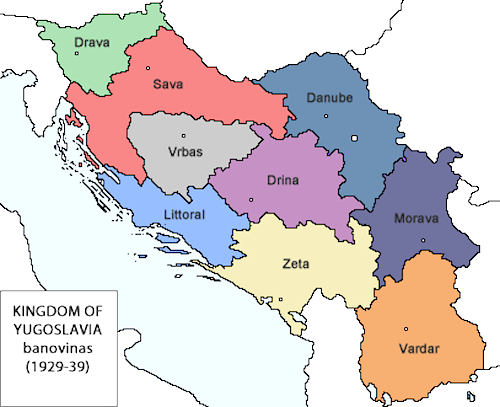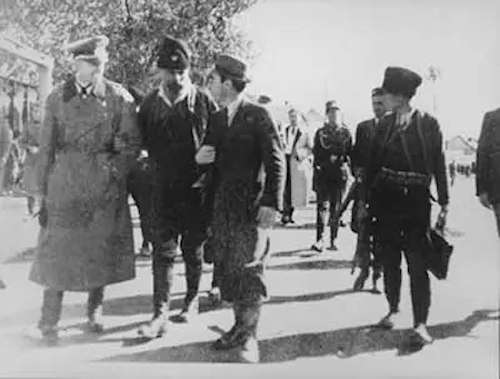In August 1914 the First World War broke out. The Serbian army, defeated in numerous battles, was forced to retreat towards the Adriatic passing through Kosovo which, starting from the winter between 1915 and 1916, was occupied by the troops of Austria-Hungary and Bulgaria, with the fruitful support of the Albanian population.
At the end of hostilities, in the winter of 1918, the Serbian army returned to Kosovo and repelled the troops of the Quadruple Alliance, taking revenge for the occupation with unspeakable atrocities on the population.
After the defeat of the Central Powers in November 1918, Serbia and Montenegro merged into the new Kingdom of Serbs, Croats and Slovenians. The Kingdom, hereinafter referred to as Kingdom of Yugoslavia, control of Kosovo and Metohija was recognized in 19191, subsequently reunited in a single region.
Thus, the province returned to the same situation created in 1913, with Kosovo formally annexed to the new Kingdom.
The monarch Alexander I then initiated contacts with Turkey in order to be able to act undisturbed in the campaign of repression he undertook against the resistance opposed by the Kacaks Albanians2 of Kosovo and come on Komitadjis in Macedonia3.
 Incidentally, in 1929 the Kingdom of Yugoslavia was organized into nine administrative regions, called banovine. Kosovo was divided between three of these: banovina of Zeta (corresponding to the areas of Kosovska Mitrovica, Peć, Djakovica and Orahovac), banovina of the Vardar (i.e. the cities of Priština, Prizren, Gnijlane and Uroševac) and banovina of the Morava (with the areas of Vučitrn, Podujevo).
Incidentally, in 1929 the Kingdom of Yugoslavia was organized into nine administrative regions, called banovine. Kosovo was divided between three of these: banovina of Zeta (corresponding to the areas of Kosovska Mitrovica, Peć, Djakovica and Orahovac), banovina of the Vardar (i.e. the cities of Priština, Prizren, Gnijlane and Uroševac) and banovina of the Morava (with the areas of Vučitrn, Podujevo).
In the interwar period, the Yugoslav monarchist government implemented a program of recolonization of Kosovo, with the aim of forcibly altering the demographic balance of the region, which at that time still had an Albanian majority.
During this period, more than 60.000 settlers, 90% of whom were Serbs, settled in the territory of the former vilayet of Kosovo4. With the support of the Turkish government, a policy of forced emigration of Albanians was then implemented.
In 1920 the Yugoslav government approved the so-called "Decree on the Colonization of the Southern Yugoslav Provinces" and already in 1931 a second, even broader one was drawn up.
Incentives were offered to war veterans to settle in Kosovo, but few responded to the call. In the 30s, Yugoslavia also signed several treaties with Turkey, which were never implemented, to welcome expelled Muslims.
Despite large-scale failures, this slow policy of ethnic and cultural cleansing continued until the eve of the Second World War, when ethnic Albanian citizens in Kosovo became less than 50% of the total.
 World War II
World War II
Following the invasion of Yugoslavia by the German and Italian armies in April 1941, their respective occupation forces divided control of the province of Kosovo. The north, rich in mineral deposits and an integral part of Serbia, was occupied by Germany, while the south, the so-called Province of Pristina, was incorporated into Albania and placed under Italian occupation.
Various Jewish communities from Serbia, Macedonia and Bulgaria took refuge in the territories under Italian occupation, convinced they would find protection. Indeed, while the German armies proceeded to liquidate the Jewish population of the Novi Pazar and Kosovska Mitrovica areas in March 1942, most Jews in Italian Kosovo could count on protection from the local population until the end of the war. Others, however, were handed over by the Italians to the Nazis.
The Albanians of Kosovo viewed the collapse of Yugoslavia with favor and collaborated with the Italians and Germans to achieve the great political goal of unification with Albania.
Over the course of the conflict, more than 100.000 Serbs and Montenegrins were expelled or killed, and Serbian authorities counted more than 70.000 refugees from Kosovo.
 The situation worsened further with the fall of Fascism in 1943 and the subsequent direct Nazi occupation of Kosovo. Hierarch Heinrich Himmler, then head of the SS, worked to establish the XXI Waffen SS "Skanderbeg" division, essentially employing Albanian personnel, which had as its first objective the control of the territory occupied by the German forces. The actions of the division led to the massacre of several thousand ethnic Albanian citizens as a response to the exploits of the partisan rebel forces.
The situation worsened further with the fall of Fascism in 1943 and the subsequent direct Nazi occupation of Kosovo. Hierarch Heinrich Himmler, then head of the SS, worked to establish the XXI Waffen SS "Skanderbeg" division, essentially employing Albanian personnel, which had as its first objective the control of the territory occupied by the German forces. The actions of the division led to the massacre of several thousand ethnic Albanian citizens as a response to the exploits of the partisan rebel forces.
The appeals of the communist partisans to animate an anti-German revolt in Kosovo, however, had no impact on the local population. After numerous uprisings by Albanian partisans, led by Fadil Hoxha in Kosovo and Enver Hoxha5 in Albania, Kosovo was liberated at the end of 1944 thanks to the Albanian communists and with the help of the Yugoslavs.
The country then became a Serbian province of the new Yugoslav Republic.
The Kosovar forces were defeated in mid-1945 but the armed resistance continued and the firefights, although sporadic, only ended in 1948.
(Go on)
Read: "Kosovo (part one): a history spanning millennia"
Read: "Kosovo (second part): the Ottoman Empire"
Read: "Kosovo (third part): the Balkan Wars (1912-1913)"
Read: "Kosovo (fifth part): Socialist Yugoslavia and the Pristina Spring"
Read: "Kosovo (sixth part): towards conflict"
1 Metochìa is a region characterized by a large plateau which in fact constitutes the area of the drainage basin of the Drin river included within the borders of Kosovo, of which it represents the western half. Administratively it is made up of three districts (out of 7) and contains approximately 40% of the population of the entire Kosovo. Political union with the rest of the country officially occurred in 1946 when the then Yugoslavia created the Autonomous Province of Kosovo (Kosovo and Metohija).
2Kachak (o leakage) is a term of Turkish origin to identify a "rebel" or a "bandit". In Albania the term is used to define the protagonist units of the guerrilla warfare conducted by the revolutionaries who fought in the period of the Albanian resurgence, at the beginning of the XNUMXth century, in Kosovo.
3 I Komitadji (o Comitadjis) were members of the rebel gangs that operated in the Balkans during the final period of the Ottoman Empire. They fought against the Turkish authorities and were supported by the governments of neighboring states, especially Bulgaria.
4 Il vilayet of Kosovo was a vilayet of the Ottoman Empire, corresponding to various areas of present-day Serbia, Kosovo, Montenegro, Macedonia and Albania.
5 Enver Hoxha (1908 - 1985) was an Albanian revolutionary, politician and military man. He was supreme leader of Albania from 1944 to 1985.
Photo: web












